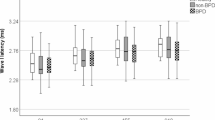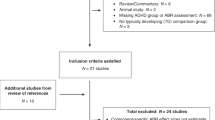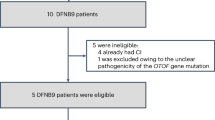Abstract
Maximum length sequence brainstem auditory evoked response (BAER) was studied within the first week after birth in 28 term neonates who had perinatal hypoxia-ischemia, or asphyxia. In the BAER recorded using conventional averaging techniques (click rate 21/s), the only abnormality was a slight increase in III–V interval, in addition to an increase in wave latencies when including those who had an elevated threshold (t test, all p < 0.05). In the maximum length sequence BAER, however, both the III–V and I–V intervals in the asphyxiated infants were significantly increased at all the 91/s, 227/s, 455/s, and particularly 910/s click rates (p < 0.05–0.001). The I–III interval was also increased significantly at 455/s and 910/s click rates (both p < 0.05). Wave V amplitude was significantly reduced at all the click rates used (ANOVA, p < 0.05–0.001), particularly at 910/s, which sometimes was the only abnormality indicative of brain damage. Both the amplitude ratios V/I and V/III were significantly decreased at 455/s and 910/s click rates (p < 0.01 or 0.001). A general trend was that BAER abnormalities after hypoxia-ischemia became more prominent as click rate was increased. Significant abnormalities occurred mainly at very high click rates (455/s and 910/s), which can be achieved using the maximum length sequence technique but not by using conventional averaging techniques. Thus, this technique, which can be used at the cribside, appears to be a better method for the early detection of brain damage after hypoxia-ischemia than using conventional averaging techniques, enhancing the diagnostic value of the BAER.
Similar content being viewed by others
Log in or create a free account to read this content
Gain free access to this article, as well as selected content from this journal and more on nature.com
or
Abbreviations
- BAER:
-
brainstem auditory evoked response
- nHL:
-
normal hearing level
- HI:
-
hypoxia-ischemia
- MLS:
-
maximum length sequence
References
Evans DJ, Levene MI 1999 Hypoxic-ischaemic injury. In: Rennie JM, Roberton NRC (eds) Textbook of Neonatology. Churchill-Livingstone, Edinburgh, pp 1231–1251
Levene MI 1992 The asphyxiated newborn infant. In: Levene MI, Bennett MJ, Punt J (eds) Fetal and Neonatal Neurology and Neurosurgery. Churchill-Livingstone, Edinburgh, pp 405–425
Hecox K, Cone B, Blaw M 1981 Brainstem auditory evoked response in the diagnosis of pediatric neurologic diseases. Neurology Ny 31: 832–839
Jiang ZD 1998 Maturation of peripheral and brainstem auditory function in the first year following perinatal asphyxia: a longitudinal study. J Speech Lang Hear Res 41: 83–93
Jiang ZD, Tierney TS 1996 Long-term effect of perinatal and postnatal asphyxia on developing human auditory brainstem responses: brainstem impairment. Int J Pediatr Otorhinolaryngol 34: 111–127
Karmel BZ, Gardner JM, Zappulla RA, Magnano CL, Brown EG 1988 Brain-stem auditory evoked responses as indicators of early brain insult. Electroencephalogr Clin Neurophysiol 71: 429–442
Majnemer A, Rosenblatt B, Riley P 1988 Prognostic significance of the auditory brainstem evoked response in high-risk neonates. Dev Med Child Neurol 30: 43–52
Jiang ZD, Tierney TS 1996 Binaural interaction in human neonatal auditory brainstem. Pediatr Res 39: 708–714
Jiang ZD 1998 Outcome of brainstem auditory electrophysiology in children who survived purulent meningitis. Ann Otol Rhinol Laryngol 108: 429–434
Jiang ZD, Brosi DM, Wilkinson AR 1998 Immaturity in electrophysiological response of the neonatal auditory brainstem to high repetition rates of click stimulation. Early Hum Dev 52: 133–143
Henderson-Smart DJ, Pettigrew AG, Edwards DA, Jiang ZD 1991 Brain stem auditory evoked responses: physiological and clinical issues. In: Hanson MA (ed) The Fetal and Neonatal Brain Stem: Developmental and Clinical Issues. Cambridge University Press, Cambridge, pp 211–229
Chiappa KH 1990 Brainstem auditory evoked potentials: methodology. In: Chiappa KH (ed) Evoked Potentials in Clinical Medicine. Raven Press, New York, pp 173–221
Gerling IJ, Finitzo-Hieber T 1983 Auditory brainstem response with high stimulus rates in normal and patient populations. Ann Otol Rhinol Laryngol 92: 119–123
Pratt H, Ben-David Y, Peled R, Podoshin L, Scharf B 1981 Auditory brain stem evoked potentials: clinical promise of increasing stimulus rate. Electroencephalog Clin Neurophysiol 51: 80–90
Jiang ZD, Brosi DM, Wilkinson AR 1998 Maximum length sequence brainstem evoked response: a potentially sensitive means to detect neural dysfunction of the brain in high risk neonates. Abstract 290 in Final Programme of 19th Annual Conference of the European Society for Pediatric Research, p 97
Jiang ZD, Brosi DM, Wilkinson AR 1999 Detection of auditory impairment in high-risk infants using MLS BAER. Pediatr Res 45: 343Aabstr
Eysholdt U, Schreiner C 1982 Maximum length sequences: a fast method for measuring brainstem evoked responses. Audiology 21: 242–250
Burkard R, Shi Y, Hecox KE 1990 Brainstem auditory evoked responses elicited by maximum length sequences: effects of simultaneous masking noise. J Acoust Soc Am 87: 1665–1672
Lasky RE 1997 Rate and adaptation effects on the auditory evoked brainstem response in human newborns and adults. Hear Res 111: 165–176
Lasky RE, Perlman J, Hecox KE 1992 Maximum length sequences auditory evoked brainstem responses in human newborns and adults. J Am Acad Audiol 3: 383–389
Picton TW, Champagne SC, Kekkett AJ 1992 Human auditory evoked potentials recorded using maximum length sequences. Electroencephalog Clin Neurophysiol 84: 90–100
Jiang ZD, Brosi DM, Wilkinson AR 1999 Neonatal brainstem auditory evoked response recorded using maximum length sequences. Biol Neonate 76: 193–199
Yudkin PL, Aboualfa M, Eyre JA, Redman CWG, Wilkinson AR 1987 New birthweight and head circumference centile for gestational ages 24 to 42 weeks. Early Hum Dev 15: 45–52
Ken-Dror A, Pratt H, Zeltzer M, Sujov P, Katzir J, Benderley A 1987 Auditory brainstem evoked potentials to clicks at different presentation rates: estimating maturation of pre-term and full-term neonates. Electroencephalog Clin Neurophysiol 68: 209–218
Zaaroor M, Starr A 1991 Auditory brain-stem evoked potentials in cat after kainic acid induced neuronal loss: I. Superior olivary complex. Electroencephalog Clin Neurophysiol 80: 422–435
Zaaroor M, Sarr A 1991 Auditory brain-stem evoked potentials in cat after kainic acid induced neuronal loss: II. Cochlear nucleus. Electroencephalog Clin Neurophysiol 80: 436–445
Benveniste H, Drejer J, Schousboe A, Diemer NH 1984 Elevation of the extracellular concentrations of glutamate and aspartate in rat hippocampus during transient cerebral ischemia monitored by intracerebral microdialysis. J Neurochem 43: 1369–1374
Represa A, Tremblay E, Ben-Ari Y 1989 Transient increase of NMDA-binding sites in human hippocampus during development. Neurosci Lett 99: 61–66
Acknowledgements
The authors thank Dr. Yun Cao in Shanghai Medical University for assisting in the collection of part of the data. We also thank the nurses and pediatricians at the Neonatal Unit of the Department of Paediatrics and the Department of Obstetrics and Gynaecology for their assistance in the recruitment of subjects.
Author information
Authors and Affiliations
Additional information
Supported by the Wellcome Trust, R&D Anglia and Oxford Regional Health Authority, Children Nationwide Medical Research Fund, and an Allen & Hanburys Research Award to Z.D. Jiang by the Royal College of Paediatrics and Child Health, U.K.
Dr. Ze Dong Jian, Neonatal Unit, Department of Paediatrics, John Radcliffe Hospital, Headington, Oxford OX3 9DU, United Kingdom.
Rights and permissions
About this article
Cite this article
Jiang, Z., Brosi, D., Shao, X. et al. Maximum Length Sequence Brainstem Auditory Evoked Responses in Term Neonates Who Have Perinatal Hypoxia-Ischemia. Pediatr Res 48, 639–645 (2000). https://doi.org/10.1203/00006450-200011000-00015
Received:
Accepted:
Issue date:
DOI: https://doi.org/10.1203/00006450-200011000-00015



